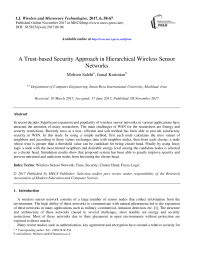A Trust-based Security Approach in Hierarchical Wireless Sensor Networks
Автор: Mohsen Salehi, Jamal Karimian
Журнал: International Journal of Wireless and Microwave Technologies(IJWMT) @ijwmt
Статья в выпуске: 6 Vol.7, 2017 года.
Бесплатный доступ
In recent decades Significant expansion and popularity of wireless sensor networks in various applications have attracted the attention of many researchers. The main challenges of WSN for the researchers are Energy and security restrictions. Recently trust as a new, efficient and soft method has been able to provide satisfactory security in WSN. In this study by using a simple method, first each node calculates the trust values of neighbors and according to these values exchanges data with neighbor nodes, then from each cluster, a node whose trust is greater than a threshold value can be candidate for being cluster head. Finally by using fuzzy logic a node with the most trusted neighbors and desirable energy level among the candidate nodes is selected as a cluster head. Simulation results show that proposed system has been able to greatly improve security and prevent untrusted and malicious nodes from becoming the cluster head.
Wireless Sensor Network, Trust, Security, Cluster Head, Fuzzy Logic
Короткий адрес: https://sciup.org/15013006
IDR: 15013006
Список литературы A Trust-based Security Approach in Hierarchical Wireless Sensor Networks
- T. Bin, Y. YANG, L. Dong, LI. Qi, XIN. Yang, "A security framework for wireless sensor networks," The Journal of China Universities of Posts and Telecommunications 17, 2010, pp.118-122.J. Clerk Maxwell, A Treatise on Electricity and Magnetism, 3rd ed., vol. 2. Oxford: Clarendon, 1892, pp.68-73.
- MK. Jain, "Wireless sensor networks: Security issues and challenges," International Journal of Computer and Information Technology 2.1, 2011, pp.62-67.
- V. Umarani, KS. Sundaram. "Survey of Various Trust Models and Their Behavior in Wireless Sensor Networks," 2013.
- S. Ganeriwal, L.K. Balzano, M.B. Srivastava, "Reputation based framework for high integrity sensor networks," Proceedings of the 2nd ACM Workshop on Security of adhoc and Sensor Networks, 2004, pp.66–77.
- Z.Yao, D.Kim, Y.Doh, "Parameterized and localized trust management scheme for sensor networks security," IEEE International Conference on Mobile adhoc and Sensor Systems, MASS, 2008, pp.437–446.
- H. Chen, H.Wu, X.Zhou, C.Gao, "Agent-based trust model in wireless sensor networks," 8th ACIS International Conference on Software Engineering, Artificial Intelligence, Networking, and Parallel Distributed Computing, 2007, pp. 119–124.
- R.A. Shaikh, H.Jameel, B.J.d’Auriol, H.Lee, S.Lee, Y.J.Song, "Group-based trust management scheme for clustered wireless sensor networks," IEEE Transactions on Parallel and Distributed Systems 20 (11), 2009, pp.1698–1712.
- Y.Zhou, T.Huang, W.Wang, "A trust establishment scheme for cluster-based sensor networks," 5th International Conference on Wireless Communications, Networking and Mobile Computing, 2009, pp. 1–4.
- Z.Liu, Z.Zhang, S.Liu, Y.Ke, J.Chen, "A trust model based on Bayes theorem in WSNs," 7th International Conference on Wireless Communications, Networking and Mobile Computing, WiCOM, 2011, pp. 1–4.
- T.K. Kim, H.S. Seo, "A trust model using fuzzy logic in wireless sensor network," Proceedings of World Academy of Science Engineering and Technology, 2008, pp. 63–66.
- R.Feng, X.Xu, X.Zhou, J.Wan, "A trust evaluation algorithm for wireless sensor networks based on node behaviors and D–S evidence theory",Sensors 11(2), 2011, pp. 1345–1360.
- Han, G., Jiang, J., Shu, L., Niu, J., & Chao, H. C. "Management and applications of trust in Wireless Sensor Networks, A survey," Journal of Computer and System Sciences 80.3, 2014, pp. 602-617.
- WT. L, J. Patel, NR. Jennings, and M. Luck, "Coping with Inaccurate Reputation Sources:Experimental Analysis of a Probabilistic Trust Model," Proceedings of the fourth international joint conference on Autonomous agents and multiagent systems, 2005, pp. 997-1004.
- A. Josang, E.Gray, M. Kinateder, "Simplification and Analysis of Transitive Trust Networks," Web Intelligence and Agent Systems Journal, Vol. 4, No. 2, 2006, pp. 139-161.
- FG. Marmol, and GM. Pérez, "Security threats scenarios in trust and reputation models for distributed systems," Computers & Security 28.7, 2009, pp. 545-556.
- Y. Yu, K. Li, W. Zhou, P. Li, "Trust mechanisms in wireless sensor networks: Attack analysis and countermeasures," Journal of network and computer applications 35.3, 2012, pp. 867-880.
- Y. Sun, Z. Han, KJR. Liu, "Defense of trust management vulnerabilities in distributed networks," Communications Magazine, IEEE 46.2, 2008, pp. 112-119.
- H. Yu, Z. shen, C. Miao, C. Leung, D. Niyato, "A survey of trust and reputation management systems in wireless communications," Proceedings of the IEEE 98.10, 2010, pp. 1755-1772.
- B. Khosravifar, J. Bentahar, M. Gomrokchi, R. Alam, "CRM: An efficient trust and reputation model for agent computing." Knowledge-Based Systems 30, 2012, pp. 1-16.
- FG. Zhang, "Preventing recommendation attack in trust-based recommender systems," Journal of Computer Science and Technology 26.5 , 2011, pp. 823-828.
- Y, Yang, Q. Feng, YL. Sun, Y.Dai, "Reptrap: a novel attack on feedback-based reputation systems," Proceedings of the 4th international conference on Security and privacy in communication netowrks. ACM, 2008.
- D.Ingram, "An evidence based architecture for efficient, attack-resistant computational trust dissemination in peer-to-peer networks," Trust Management. Springer Berlin Heidelberg, 2005. pp. 273-288.
- D. Grawrock, Dynamics of a Trusted Platform: Intel Press, 2009


